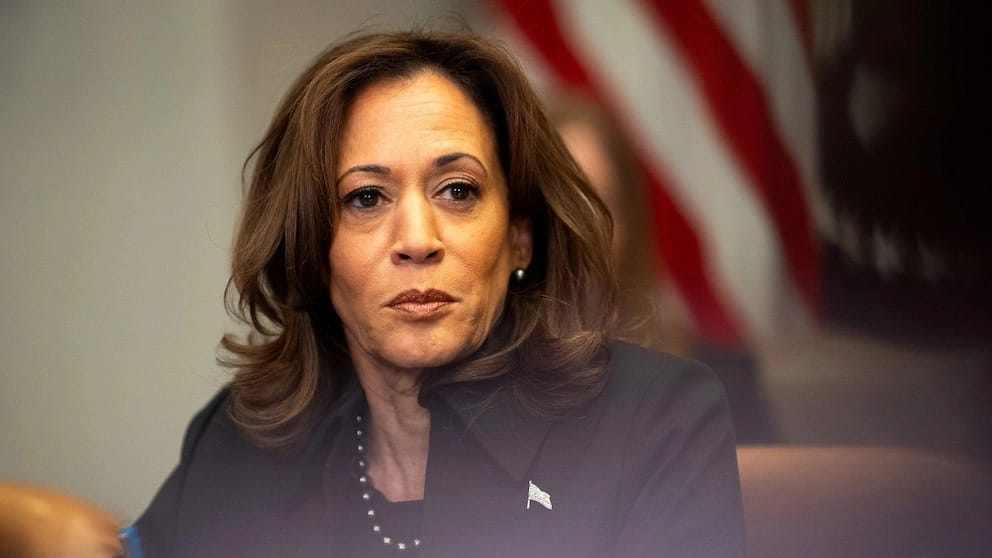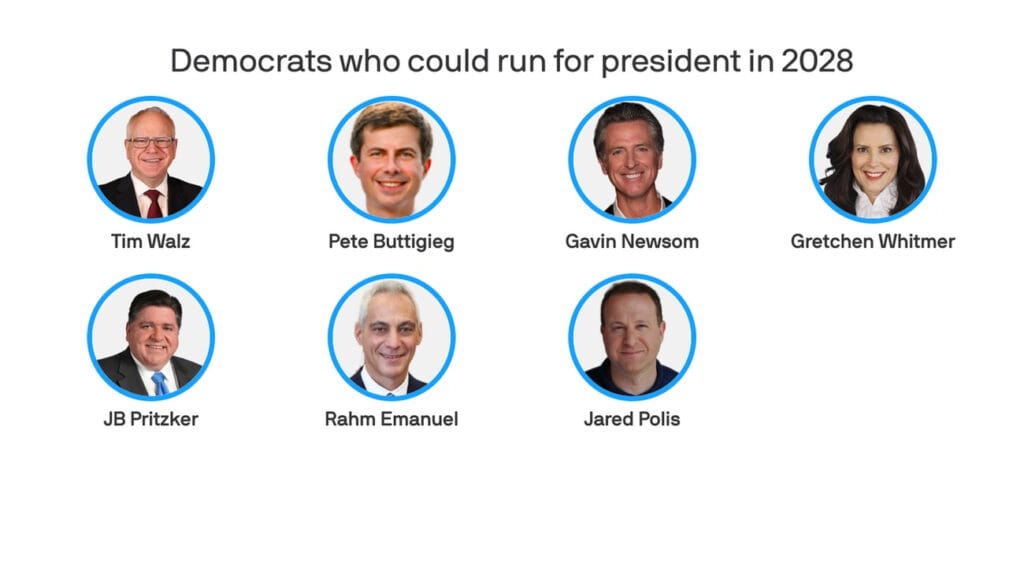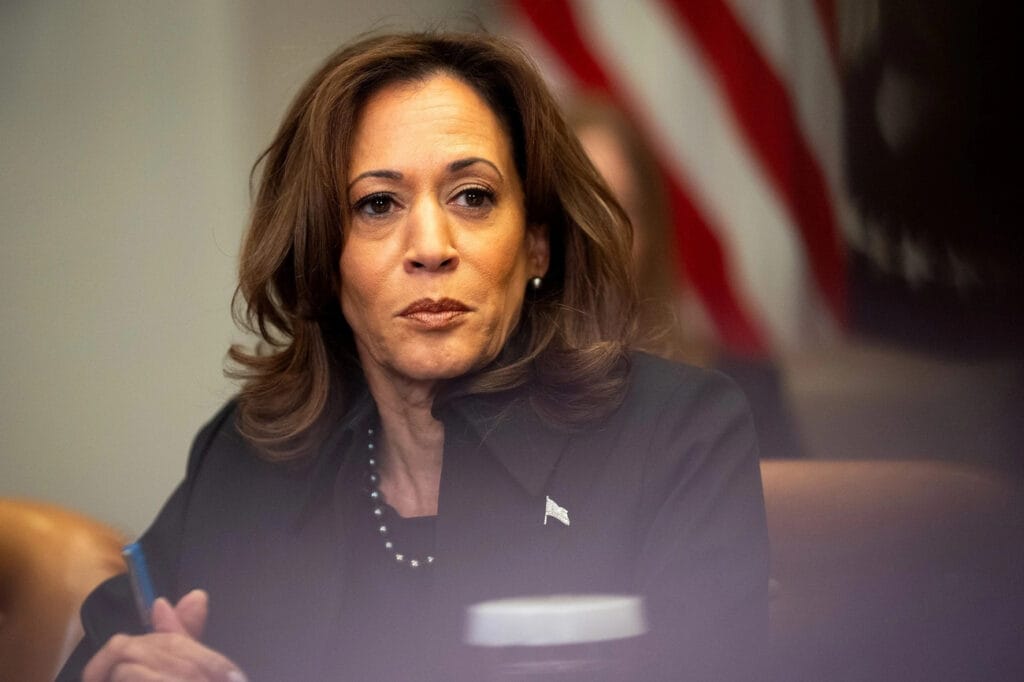While Harris keeps high approval ratings among Democrats—87% in a YouGov poll and 88% in a McLaughlin survey—her spot as the clear successor to the Democratic nomination seems less sure. Political experts point out her lack of big-picture thinking as a possible weak point for a 2028 presidential run. Furthermore, Harris is thinking about running for California governor, which makes the scene for 2028 Democratic candidates even more complex. This uncertain situation has led large donors and labour unions to hold back their support while they wait to see what Harris will do, putting other Democratic presidential hopefuls on pause.
Kamala Harris Faces Growing Doubts Within Democratic Ranks

Image Source: ABC News – The Walt Disney Company
Democrats in key positions have started to worry about Kamala Harris as a top choice for 2028 presidential candidates. The Hill asked a Democratic senator if Harris should try again in 2028. The senator, who stayed unnamed, said , “No.” They pointed out that Harris already had her shot in 2024 before Trump beat her in November.
Party leaders wonder about Harris’s future plans
Senator John Hickenlooper (D-Colo.) didn’t call Harris a frontrunner, but he said she would add “valuable perspective to the political debate”. In the same way, Senator Richard Blumenthal (D-Conn.) gave careful support, saying, “She’s an attractive and effective candidate and public official,” but then added an important point: “The question would be whether she’s the best candidate, and there will be a lot of debate about that question.”
Many political analysts say Harris’s uncertainty about her future causes problems. Her possible interest in running for California governor in 2026 creates doubt about her long-term goals for the presidency. Political experts note that if a Democrat wins in 2028, Harris will be staring at 2036—72 years old and needing to knock out an incumbent vice president.”
Grassroots activists have mixed opinions
At the community level, Harris sparks very different reactions. A Zoom call set up by Win With Black Women attracted over 40,000 participants, showing strong support among certain groups. However, regular voters seem more cautious.
At Krispy Doughnut in Atlanta’s Black West End, manager Jones confessed, “I don’t know much about her… I’ll have to do research.” Another voter, Joi Jenkins, expressed her scepticism by saying, “I’m not sure if I’d want her to lead the country.” I don’t think she can do it.”
California and South Carolina show opposite views
Harris support differs between regions. In South Carolina Democratic meetings, Harris was mentioned only if someone specifically asked about her. Wayne Borders, a left-wing activist in Columbia, asked about her 2028 chances: “Does she want it?”
At the same time, Democrats in California grow more restless as Harris hesitates to decide about running for governor. “We haven’t heard from her on California issues since Trump took office,” said Madison Zimmerman, a state party delegate from Shasta County. She added, “I think California isn’t a consolation prize.” David Campos, the party’s vice chair, summed up the feeling: “People want to have a campaign, an election” instead of a coronation for any candidate, including Harris.
Rising Democratic Stars Gain Momentum in Early Polls

Image Source: Axios
New poll numbers show a changing scene for Democratic presidential hopefuls in 2028, with Pete Buttigieg, the former transportation secretary, taking the lead. As several up-and-coming candidates prepare for potential White House runs, the contest appears to be intensifying.
Pete Buttigieg tops recent AtlasIntel poll
The latest AtlasIntel poll done from May 21-27, 2025, reveals Buttigieg has 31.5% support among Democratic voters. This shows his position has grown stronger since an earlier April survey where he got 27.7%. Election expert Nate Silver described Buttigieg, who previously served in the Biden-Harris administration, as someone a “top-rated” polling firm represents. Silver also said AtlasIntel was “the most accurate pollster in the 2024 election”.
In May 2025, Buttigieg expressed his interest in running for president during an interview with Anand Giridharadas. He said he planned to “evaluate what I can offer and how it differs from other candidates.”
Alexandria Ocasio-Cortez and Gavin Newsom close behind
Congresswoman Alexandria Ocasio-Cortez ranks second with 19.4% support, with former Vice President Harris following at 16.6%. This shows a major drop for Harris from her 24% support in April.
The public holds Ocasio-Cortez in a positive light, with a 2-point net favourability rating (46% positive, 44% negative), which places her above both Trump and Harris in public perception. Silver identifies her as the future leader who will guide Democrats through the next presidential election cycle.
California Governor Gavin Newsom sits in fifth place at 7.1%, but he’s dealing with some issues. His approval ratings among California voters are lukewarm at 46% — quite a bit lower than other potential governors in the race like Pennsylvania’s Josh Shapiro (59%), Michigan’s Gretchen Whitmer (54%), and Kentucky’s Andy Beshear (68%).
Polling volatility reflects voter uncertainty
It’s worth noting that different polling companies show very different results. While AtlasIntel always puts Buttigieg in the lead, both McLaughlin and Echelon Insights polls from May 2025 show Harris ahead with about 30% support.
These differences between surveys point to a lot of voter uncertainty about possible 2028 Democratic presidential candidates. Furthermore, the Democratic primary field remains open and difficult to predict, with significant support for candidates like Senator Cory Booker (10.4%) and others, more than two years before the first votes.
Harris Weighs Governor Bid Amid 2028 Presidential Speculation

Image Source: ABC News – The Walt Disney Company
Former Vice President Kamala Harris is currently facing a significant decision about her political future. Sources say she’ll decide by late summer if she wants to run for California governor in 2026. People are also talking about whether she’ll try for president in 2028.
Governor run could be a backup plan or smart move
Harris shows real interest in running California, with her staff pointing out she has “long been drawn to the idea of being the top boss of the world’s fifth-biggest economy and the first Black woman to govern America”. A new UC Berkeley survey revealed 50% of California voters see Harris in a positive light, with strong backing from women and people living in Los Angeles and the San Francisco Bay Area.
Some Democrats see the governor’s office as a smart career choice. “At the national level, what Newsom has achieved in that role shows a lot of potential for Harris to leverage her name recognition as the governor of the fifth-biggest economy,” a former adviser to Harris said. Furthermore, her extensive experience as a San Francisco district attorney, state attorney general, U.S. senator, and vice president in California makes her a formidable opponent.
Worries about Harris using governorship as a launch pad
Even so, doubts linger about Harris’ true intentions. Madison Zimmerman, a state party delegate, voiced her worries: “My concern about Harris is that she would be using the position, if she won, as a placeholder for a second run at the presidency.” This view resonates in Democratic circles, where some believe California deserves more than being seen as “a consolation prize”
Experts in politics stress that Harris should steer clear of seeming self-serving. “Harris must avoid anything that hints at pride, a sense of deserving, or less than total dedication to serving as governor,” one political watcher pointed out.
How this might shape the 2028 presidential race
In the end, running for governor would change the 2028 presidential scene. According to several sources, a victory would virtually eliminate the possibility of Harris pursuing a 2028 presidential run, something he is still considering. Currently, this lack of clarity has stopped the Democratic field for both races.
Big donors are waiting it out; most labour unions aren’t backing anyone yet, and a few possible candidates are thinking up backup plans in case Harris jumps in the governor’s race. What’s telling is that California Attorney General Rob Bonta pointed to Harris as his reason to run for reelection instead of governor.
Democratic Party Gets Ready for a Packed 2028 Primary Race
Big money backers and worker groups in the Democratic Party have put their 2028 plans on hold because they’re not sure what Kamala Harris will do next in politics. This wait-and-see approach is making some Democrats nervous, while others see it as a chance. Behind the scenes, possible candidates are getting ready for different outcomes.
Donors and unions hold off on backing anyone until Harris makes up her mind
Big Democratic donors have retreated, awaiting Harris’s plans before investing significant funds in 2028 campaigns. This money slowdown also affects unions, with most holding off on backing anyone until they know who’s running. People in the know say Harris’s decision—which she’ll make by late summer—about running for California governor has put both the governor and president races on hold.
“The party doesn’t have a great image right now,” said Grant Davis Reeher, who teaches political science at Syracuse University. “The smart move might be to wait until after the midterms and then start promoting themselves.”
Other Democrats eyeing the 2028 presidential race get ready
In these uncertain times, potential candidates are starting to put themselves out there through well-planned public events. Minnesota’s Governor Tim Walz, Maryland’s Governor Wes Moore, and Illinois’ Governor J.B. Pritzker have each gone to South Carolina—the state where Democrats kick off their primaries. At the same time, Senator Amy Klobuchar is set to speak at a big Democratic dinner in New Hampshire, while Pete Buttigieg held a town hall with veterans in Iowa.
Several Democratic politicians now use podcasts as their campaign tool. Governor Gavin Newsom started the “This is Gavin Newsom” podcast to engage in discussions with right-wing figures such as Steve Bannon and Charlie Kirk, aiming to demonstrate his moderate stance. Governor Andy Beshear of Kentucky launched “The Andy Beshear Podcast” to discuss his potential presidential ambitions.
Party experts argue about the best way to beat Trump
Democratic strategists disagree on the most effective strategy for 2028. While some strategists prefer to take a cautious approach and appeal to middle-class voters, others advocate for more direct action and protests. Rep. Elissa Slotkin (D-Mich.) just rolled out what she calls a “military-style operational plan”, telling Democrats to fix their image as “weak and woke”.
But some strategists think a message of economic populism might work better. “People are even selling AOC short right now because I think there’s a hunger for that kind of populist message,” said one Democratic consultant. This split in strategy shows the party’s ongoing hunt for direction as it gets ready for what could be a packed and high-stakes primary season.
Conclusion
The Road to 2028: A Democratic Party at a Crossroads
Democratic presidential hopes for 2028 remain uncertain, with surprising changes and calculated moves. Kamala Harris, once thought to be the clear successor, now struggles against emerging party talents. Pete Buttigieg leads early polls with 31.5% support, while Alexandria Ocasio-Cortez follows at 19.4%. Harris lags behind with 16.6% backing.
Kamala Harris has a big choice to make about her political career. Her thinking about running for governor of California has put the whole Democratic field on hold. Big donors are waiting. Labour unions are slow to back anyone. Other possible candidates are making backup plans.
Things look very different from past elections. Party insiders doubt if Harris can lead the party, with one Democratic senator saying outright she already had her chance. Regional support for Harris is widespread, with South Carolina Democrats praising her and California Democrats growing weary of waiting for her decision.
Despite this, many candidates still have a chance. Governors Tim Walz, Wes Moore, and J.B. Pritzker show up in early primary states. Senators Amy Klobuchar and Cory Booker craft their messages to position themselves. This competition helps Democratic voters by giving them a chance to hear solid policy debates before they pick their next nominee.
Democratic strategists don’t agree on the best way forward. Some think the party should stay in the middle to attract moderate voters. Others want to focus on economic issues for the common people, thinking candidates like Ocasio-Cortez might tap into the growing dislike of the establishment. These differences in strategy show how the party is still trying to find its way after losing elections.
While 2028 may seem far off, today’s actions will shape the future leadership race. The Democratic Party now faces a key decision: can they back Harris despite her current low poll numbers or welcome the competitive primary process that’s unfolding? Regardless of Harris’s decision, it is undeniable that Democratic voters, not party elites, will determine who leads their ticket against the Republicans in the upcoming presidential election.
FAQs
Q1. Who are the top candidates for the 2028 Democratic presidential nomination?
Based on recent polls, Pete Buttigieg, Alexandria Ocasio-Cortez, and Kamala Harris stand out as top contenders. Yet, the race remains open, with other possible candidates like Gavin Newsom and Cory Booker also gaining support.
Q2. What factors are impacting Kamala Harris’s decision to run for president in 2028?
Harris considers several elements, such as her current poll standings, possible interest in running for California governor in 2026, and the broader political scene. Her choice will shape the Democratic primary field.
Q3. How are Democratic donors and unions responding to the uncertainty surrounding the 2028 nomination?
Many big donors and labour unions are holding off on endorsements and money promises until they get a clearer picture of who’s running, as Kamala Harris plans to do.
Q4. What strategies are potential Democratic candidates using to position themselves for 2028?
People who might run are showing up at important events in early primary states, starting podcasts, and shaping what they say in public to attract different groups of Democratic voters.
Q5. How might the Democratic Party’s strategy for defeating Republicans in 2028 differ from previous elections?
A clash of ideas is happening inside the party about the best way forward. Some campaign experts suggest taking a middle-ground practical approach to win over swing voters. Others argue for pushing a more populist economic message to fire up core supporters.

